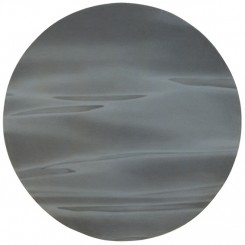“Hou Yong solo exhibition,” solo exhibition by Hou Yong.
Space Station (798 Dashanzi Art District, 4 Jiuxianqiao Lu, Chaoyang, Beijing). Jun 2 to Jun 23, 2012.
Its profile may be lower than other galleries in 798, but Space Station should by now have a reputation for strong and inventively installed exhibitions by emerging artists. The latest of these was Hou Yong, a painter born in 1976 in Beijing, whose solo outings to date have been aqueous in theme. A long-running series called Black from circa 2006–2008 shows figures swimming in glossy, dark water. The horizon line could be at the top of the composition so that the sea’s area engulfs them; sometimes, there are only wave patterns consuming the entire canvas.
On show at Space Station was a series of works from 2008 to the present, the majority having been made last year. They are on round or rectangular canvases (a couple with curved corners) giving an initial impression of a series of cabin windows onto unbroken, hyper-real brine. They glow with potent hues of emerald green and cerulean greys — accumulations of the smooth touch of pencils on canvas, and from afar, nearly photographic. There are no longer any figures stirring these waves, either physically or conceptually. The works lose nothing by the subtraction of a figural element; indeed, they gain strength from its absence.
One therefore surveyed a series of paintings hanging tensely between realism and abstraction, at once residual and self-contained — mere memories of swimmers’ movement or products of reflection on the visual quality of water alone. The lack of figures is crucial also for the paintings’ formal qualities: there is only water, and even this affinity is slipping. For what Hou Yong has depicted is an unnatural, analogous liquid visualized repeatedly without the help of photographs and to which real water, never truly still, becomes a foil.
Ultimately, these enlarged, absorbing ripples might take on a spiritual aura. At the same time, however, their formal qualities as art affirm the work of the artist in a humanist vein, hinting even at the relationship with the substance on which all life depends. Thus does the conceptual scope of Hou Yong’s current practice become clear.
